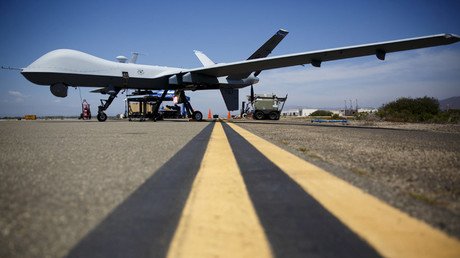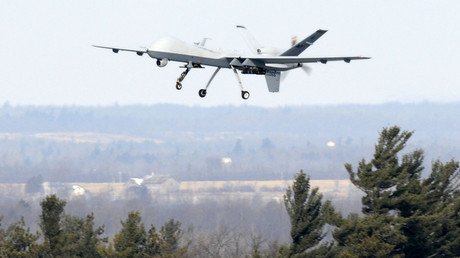Drones Я Us: Obama’s UAV program falling wide of legal targets

With a dozen drone bases already worldwide, the US military is increasingly relying on its unmanned aerial vehicles to take out suspected terrorists, while innocent civilians are becoming collateral damage. Meanwhile, a glimpse behind the program’s iron curtain is strictly prohibited.
According to a report by the Stimson Center, a Washington-based nonpartisan institution, the Obama administration has earned an ‘F’ for a lack of transparency over its global drone program.
“In terms of the justification for the program and the entire legal basis – that still remains out of reach of the American public,” study author Rachel Stohl told AFP. “We know very little about the actual drone operations, the missions, even in aggregate we don’t know.”
Strange the US public is not demanding some explanation over this disturbing find, especially considering drones have also targeted and killed many Americans.
Instead, the US public has quietly settled for what basically amounts to a high-level sales pitch.
In an apparently preemptive mood, retired Air Force General Michael Hayden contributed an op-ed piece to the New York Times - just days before the damning Stimson study was released - where he heaped praise on the killing system he once supervised.
In a rather implausible dialogue between an anonymous intelligence analyst and a ‘decision maker’, Hayden sets out to assure the reader that the US military goes to great pains to protect civilians before it hurls – like an enraged Zeus - deadly lightning bolts from the sky.
The article begins with the analyst and the ‘decision maker’ deciding whether or not to call in a drone strike on a suspected terrorist hideout.
“Are you sure they’re there?” the decision maker asks. “They” – Hayden informs us - are “Al-Qaeda operatives who have been planning attacks against the United States.”
“Yes, sir,” the intelligence analyst replies, ticking off the human and electronic sources of information. “We’ve got good Humnit [‘human intelligence’]. We’ve been tracking with streaming video. Signet’s checking in now and confirming it’s them. They’re there.”
A few lines later, the intelligence analyst further informs his boss: “We haven’t seen anyone since the Pred got capture of the target. But A.Q. uses it when they pass through here, and they pass through a lot.”
There’s never been a major leak of documents relating to the U.S. drone program. Until now. https://t.co/IPnqTDv5Ouhttps://t.co/Opnqg0iqCb
— The Intercept (@the_intercept) October 15, 2015
Despite this tiresome name-dropping of various intelligence-gathering agencies and devices, a full page later the almighty ‘decision maker’ asks, almost as if to satisfy some kind of perverse yearning: “Tell me again about these guys.”
Now that’s either some really bad fiction writing or some very slow decision makers. Either way, it doesn’t bode well for American liberty.
It is on the basis of this Clancy-esque style of storytelling that the American public has come to know – and willfully accept – Washington’s hit-and-miss drone program, which seems to be making America enemies faster than the US military can kill them. A bit like playing ‘whack the mole’ except in this version of the game the mole is able to strike back, usually in the form of a deadly attack on soft civilian targets.
This is exactly why the American public has every right to be informed about Washington’s top-secret drone program.
However, Hayden is content to boast of the system’s lethality, while resorting to the fear factor when he argues that bad guys overseas would unleash their attacks inside America if not for the mighty drone.
"The targeted killing program has been the most precise and effective application of firepower in the history of armed conflict," said Hayden. “Civilians have died, but in my firm opinion, the death toll from terrorist attacks would have been much higher if we had not taken action.”
But it seems Hayden is guilty of putting the cart before the horse. After all, there is a real possibility that America is being threatened by the specter of terrorism precisely due to its military activities overseas, which have left many innocent civilian in its wake.
But there are some glaring facts that Hayden decided not to mention in his op-ed piece, and probably for good reason.
As director of the CIA between May 30, 2006 and February 12, 2009, Hayden authorized an estimated 48 drone strikes, which killed 532 people, 144 of whom were civilians.
One disturbing aspect of the secretive US drone program is that it is not being used solely for the purpose of taking out terrorists who wish to do harm to America.
Drones for hire?
According to top-secret intelligence reports obtained by McClatchy News, Pakistan’s Inter-Services Intelligence Directorate (ISI) requested a US drone strike in 2006, and another five in 2007. One of these strikes took place on May 22, 2007 “after a Pakistani army assault on the [militant] compound was repulsed,” wrote Jonathan Landay. “The Pakistani army sought the strike even though it had been told that drones wouldn’t be used to support Pakistani troops in combat, said an individual familiar with the episode.”
Such strikes, which invariably kill civilians who happen to be in the vicinity of the intended target, has provoked a firestorm of criticism of US foreign policy, much of it by the citizens of countries where these extrajudicial killings are occurring.
Hayden then proceeds to discuss a particular kind of unmanned attack called “signature strikes,” in which the “identities of the people present were not known.” Or perhaps it would be better to say “not revealed.”
In June 2013, NBC News conducted a review of classified CIA documents for a 14 month period beginning in September 2010. It revealed 114 drone strikes that killed up to 613 people. However, in some of those attacks, the CIA did not know the identity of the victims.
NBC reported that “about one of every four" of those killed by drones in Pakistan were classified as ‘other militants.’
“The ‘other militants’ label was used when the CIA could not determine the affiliation of those killed, prompting questions about how the agency could conclude they were a threat to U.S. national security,” the report stated.
A former White House official told the news agency that sometimes the United States decides to execute individuals based on “circumstantial evidence.”
Well, that's certainly comforting.
In goes without saying that the temptation to abuse such daunting powers is a real cause for concern, especially since the definition as to who should be labeled a ‘terrorist’ may evolve over time to eventually include average Americans fighting on behalf of some popular (or unpopular, as the case may be) cause. That day may be closer than we realize.
Droning the Homeland
In March 2013, former Attorney General Eric Holder created a political firestorm when he said the use of military force against an American, in his home country, would be legal in an "extraordinary circumstance."
According to Holder, President Obama “could conceivably have no choice but to authorize the military to use such force if necessary to protect the homeland."
His comment was described by Senator Rand Paul as "more than frightening" and “an affront to the constitutional due process rights of all.”
However, there may be a far simpler reason for Hayden demonstrating so much enthusiasm over the drone technology, which ultimately comes down to business, as usual.
Even the Council of Foreign Relations (CFR) called out the retired four star general, who failed in his op-ed to provide full disclosure, which would have demonstrated Hayden’s conflict of interests in regards to drone technology: “Sixty days after his tenure ended, Hayden was announced as a principle of The Cherthoff Group, and later was named to the boards at Alion Science and Technology, Motorola Solutions, and Mike Baker International.”
The CFR went on to acknowledge that although it is “completely legal” for former officials to leave government service for private sector jobs, “any such strong defense of a government program by a former government official should mention the potential conflicts of interest when the author is employed by corporations that provide analytical, technical, and/or logistic support for the US military, intelligence community, and homeland security agencies.”
Mr. Hayden seriously failed in that respect, but then again such gross oversights should not surprise us too much in a presidential election year.
Perhaps the Republicans somehow feel that they will wield the omnipotent drone technology far more accurately, judicially and transparently than Barack Obama has over the course of his two terms as Commander-in-Chief.
But that would most likely be placing a bit too much faith in hope and change.
The statements, views and opinions expressed in this column are solely those of the author and do not necessarily represent those of RT.
















